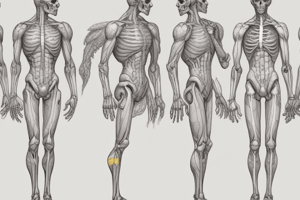Podcast
Questions and Answers
What bones make up the lower limb?
What bones make up the lower limb?
- Femur, tibia, fibula, patella, tarsals, metacarpals, phalanges
- Femur, tibia, fibula, patella, carpals, metacarpals, phalanges
- Humerus, radius, ulna, patella, tarsals, metatarsals, phalanges
- Femur, tibia, fibula, patella, tarsals, metatarsals, phalanges (correct)
What is the function of the patella?
What is the function of the patella?
- To improve ankle plantarflexion
- To improve ankle dorsiflexion
- To improve hip flexion
- To improve knee extension (correct)
Which bone is the longest, heaviest, and strongest bone in the body?
Which bone is the longest, heaviest, and strongest bone in the body?
- Femur (correct)
- Humerus
- Tibia
- Fibula
What is the function of the fibula?
What is the function of the fibula?
What changes were required in body design for vertebrates to move onto land?
What changes were required in body design for vertebrates to move onto land?
How did the placement of limbs change in later tetrapods?
How did the placement of limbs change in later tetrapods?
What is the function of the tarsals?
What is the function of the tarsals?
How did the rotation of the femur and humerus change for efficient land locomotion?
How did the rotation of the femur and humerus change for efficient land locomotion?
What is the function of the patella?
What is the function of the patella?
Which bone of the leg does not bear weight or articulate with the femur?
Which bone of the leg does not bear weight or articulate with the femur?
What is the function of the tarsals?
What is the function of the tarsals?
Which bone is the longest, heaviest, and strongest bone in the body?
Which bone is the longest, heaviest, and strongest bone in the body?
What changes in body design were required for vertebrates to transition onto land?
What changes in body design were required for vertebrates to transition onto land?
How did early tetrapods move their limbs?
How did early tetrapods move their limbs?
What is the function of the adductor muscles?
What is the function of the adductor muscles?
Why were the femur and humerus rotated in later tetrapods?
Why were the femur and humerus rotated in later tetrapods?
Study Notes
Anatomy of the Lower Limb and Evolution of Body Design for Land Locomotion
- The lower limb comprises the thigh, leg, and foot and consists of the femur, patella, tibia, fibula, tarsals, metatarsals, and phalanges.
- Bones of the lower limb are thicker and stronger to support the entire weight of the body and the forces from locomotion.
- The femur is the longest, heaviest, and strongest bone in the body, forming the hip joint at the proximal end and the knee joint with tibia and patella at the distal end.
- The patella is a triangular bone that lies anterior to the knee joint, embedded in the tendon of femoral extensors, and improves knee extension.
- The tibia is a large bone of the leg located below the knee that articulates with the femur, fibula, and tarsal bones and transmits the weight of the body to the foot.
- The fibula parallels and articulates with the tibia, does not bear weight or articulates with the femur, and forms the lateral part of the ankle joint.
- The tarsals are seven bones of the ankle that transmit body weight from tibia and fibula to the foot, while metatarsals are five bones of the foot, and phalanges are 14 bones of the toes.
- The transition of vertebrates onto land required changes in body design, including strengthening and ossification of limbs due to gravity and lack of buoyancy, and axial skeleton changes.
- The loss of direct attachment between pectoral girdle and head reduced jarring to the head caused by limb impact on the ground.
- Early tetrapods moved limbs splayed out to the side, requiring large muscles to move the limbs towards the midline, almost like walking while doing push-ups, which is not an efficient use of energy.
- Later tetrapods have their limbs placed under their bodies, requiring less force to move forward, resulting in decreased adductor muscle size and increased range of motion of scapulae.
- The femur and humerus were rotated so that the limbs and digits pointed forward in the direction of motion, producing a stride that is more efficient for moving over land.
Studying That Suits You
Use AI to generate personalized quizzes and flashcards to suit your learning preferences.
Description
How well do you know the anatomy of the lower limb and the evolution of body design for land locomotion? Test your knowledge with this quiz that covers the bones and joints of the lower limb, including the femur, patella, tibia, fibula, tarsals, metatarsals, and phalanges. Explore the changes in body design that were necessary for vertebrates to move from water to land, including adaptations to support the body weight and absorb the impact of limbs hitting the




